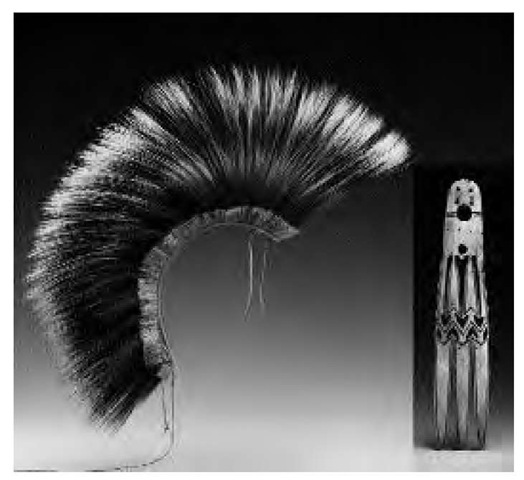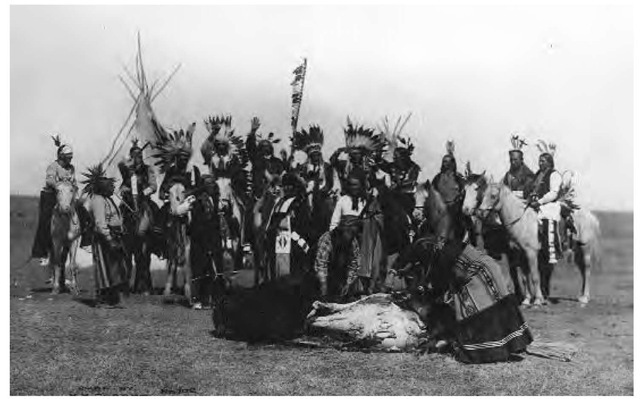Ponca is a word possibly meaning "sacred head." The Ponca are linguistic and cultural relatives of the Omaha.
Pawnee warriors stiffened a lock of hair with paint and fat, making it curve like a horn (a style known as a roach). Made in 1910, this roach, made of porcupine and deer guard hairs, is over 11 inches long and 8 inches high. The roach was tied to the wearer’s scalplock by means of a thong and a carved comblike roach spreader.
Location Poncas inhabited present-day northeast Nebraska in the late seventeenth century. Today, Northern Poncas live mostly in Nebraska, South Dakota, and Iowa, and most Southern Poncas live in north-central Oklahoma.
Population The late-seventeenth-century Ponca population was about 800. In 1993 there were about 2,360 Southern Poncas and perhaps 900 Northern Poncas.
Language Ponca, with Kaw, Omaha, Osage, and Quapaw, is part of the Dhegiha division of the Siouan language family.
Historical Information
History Dhegiha speakers probably originated in the southeast and entered the Plains from the Ohio Valley. After arriving at the Mississippi in the mid-sixteenth century, the Ponca traveled upriver with the Kaw, Omaha, and Osage. Continuing north with the Omaha into Iowa and Minnesota, the groups settled on the Big Sioux River near the pipestone quarries.
Ponca Indians skinning a buffalo.
Pressure from the Dakota forced them to the Lake Andres area of South Dakota, where they separated from the Omaha in the early to mid-seventeenth century. From there they traveled west to the Black Hills and then east again, rejoining the Omaha and moving south along the Missouri River to Nebraska. They settled on the mouth of the Niobrara River around 1763. The Omaha left them soon after to settle on Bow Creek.
Epidemics had reduced the Ponca population by over 90 percent by the time they encountered the Lewis and Clark expedition in 1804. Poncas were generally friendly with Americans and eager to trade. Treaties with the United States, beginning in 1817, cost them over two million acres of land. In 1858, the people accepted a reservation of about 100,000 acres and promises of protection against Lakota tribes. However, ten years later the Lakota successfully claimed most of this land in the 1868 Fort Laramie Treaty. Lakota attacks were worse then ever, since they now controlled the disputed land by treaty.
In contravention of the treaties and in the face of active resistance of the chiefs, the United States forced the Poncas to remove to the Indian Territory (Oklahoma). There the Indians received a reservation of just over 100,000 acres near the Arkansas and Salt Fork Rivers. Within a year, about a quarter of the tribe died in those new lands from hunger and disease.
In 1877, Chief Standing Bear and others led their people on a 500-mile walk back to the Niobrara River to bury their dead. They were arrested and detained, but a precedent-setting trial established their rights both to legal standing and to their Nebraska land, to which they soon returned. Fearing for the very survival of the reservation system, however, not to mention the corrupt system of supplying reservation Indians with substandard food and materials, the United States refused permission for the rest of the Poncas to return to Nebraska. From then on, Poncas living in Nebraska were known as Northern Ponca, and the Southern Ponca remained in Oklahoma.
The Oklahoma land was allotted 1908. Most people later sold their allotments or leased them to non-Indians. Among the Southern Ponca, strong antiallotment sentiment led to factionalism within the tribe. Two Poncas were among those who established the Native American Church in the 1910s; the church’s first president was a Ponca.
The Northern Ponca were formally "terminated" in the 1950s. By the mid-1960s, over 400 Poncas had lost all of their remaining 834 acres of land. The Ponca Clyde Warrior and a Paiute, Mel Thom, formed the National Indian Youth Council, a group dedicated to advancing Indian rights, in 1961.
Religion Wakanda was the Great Spirit or universal creator. All things had supernatural power, which could be accessed through guardian spirits obtained in vision quests. The original tribal Sacred Pipe was carved of catlinite when the Ponca lived in Minnesota. It was used in the Pipe Dance and on other occasions, as were its later replacements. Other important events included the Medicine Lodge ceremony, Sun Dance, and War Dance. The Ponca Sun Dance included self-torture. Shinny, a ball game, also had religious import.
Government Hereditary chiefs governed the clans. On the Plains, buffalo police kept order during the hunt.
Customs Two divisions, Chighu and Wazhazha, were each subdivided into four patrilineal clans. The people wrapped corpses in buffalo robes with food and other articles and buried them in graves. The people adopted scaffold burial with other aspects of Plains life. The mourning period lasted up to a year. The Ponca envisioned two afterworlds, a happy one for the worthy dead and an unhappy one for unworthy spirits.
Dwellings The Ponca built permanent villages on bluffs over rivers and fortified them with log and earth stockades. They lived in east-facing earth or hide-covered lodges. There was also a ceremonial earth lodge. Skin tipis were used on buffalo hunts.
Diet Women grew corn, beans, squash, pumpkins, and tobacco in gardens located on river bottomlands. There were two annual communal buffalo hunts. Before the people acquired horses, buffalo were often stampeded over cliffs. Men also hunted other large and small game. The people ate fish as well as a variety of wild foods.
Key Technology Material goods included pottery, mats, baskets woven from willow and bullrush stems, and trunks and boxes of cut, folded, and sewn rawhide.
Trade Poncas were involved in the early-eighteenth-century slave trade, selling mainly Pawnees to the French, from whom they received guns, among other items.
Notable Arts Notable art items included carved wooden goods, blue clay pottery, woven mats and baskets, and work in quills and beads in floral and geometric designs.
Transportation Around 1730 the people acquired horses, which then began pulling the travois. They used rawhide bull-boats for crossing rivers.
Dress Women tanned the skins and made the clothing. They wore a one-piece dress and moccasins. Men wore leggings and breechclout as well as moccasins. Cold weather gear included shirts, mittens, robes, and caps. On the Plains men wore their hair long, a custom they probably adopted from the Dakota.
War and Weapons Weapons included the bow and arrow, buffalo-hide shield, and wooden war club. The Omaha were alternately allies and enemies. The Dakota were generally enemies. On the Plains, the Ponca acquired the institution of rival military clubs, probably from the Tetons.
Contemporary Information
Government/Reservations Since 1990, the Northern Ponca tribe has reacquired 413 acres of its former reservation and is continuing to add to its land base. The people are also involved in reestablishing a tribal government and constitution.
The Southern Ponca are located in north-central Oklahoma. They adopted a constitution and by-laws in 1950. The tribe is governed by a seven-member Tribal Business Committee.
Economy High unemployment is endemic among the Northern Ponca. An economic development plan remained to be implemented in the late 1990s. The Southern Ponca run a bingo facility and a smoke shop.
Legal Status The Ponca Tribe of Nebraska (Northern Ponca) was federally rerecognized in 1990. The Ponca Tribe of Oklahoma (Southern Ponca) is a federally recognized tribal entity.
Daily Life Termination cost the Northern Ponca a great deal in the way of cultural survival. Among these people, the War Dance Society survives. Annual powwows feature traditional singing and dancing. Members participate in Sun Dances held by other tribes. Few speak the native language, but it is closely related to Omaha, which is more widely spoken. The people, who suffer especially from diabetes and hypertension, are generally less healthy than are those of the nearby non-Indian community. The Northern Ponca would like formally to reestablish their reservation.
The Southern Ponca built many facilities in the 1970s, including a clinic, headquarters, cultural center, and gymnasium. The factionalism that beset these people in the 1970s and 1980s eased in the 1990s. The annual Southern Ponca powwow is intertribal in nature. The Ponca Indian War Dance Society, formed in the 1950s from old traditions, sponsors semiannual dances. The people also perform a scalp dance and various other dances. There are regular games of shinny, especially in the spring. A regional tribal center and museum are planned. Many Poncas are Christians and/or members of the Native American Church.


